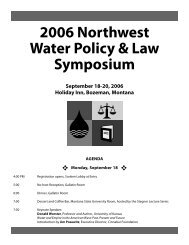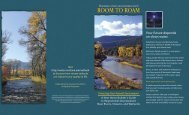aquaculturehealth - Montana Water Center - Montana State University
aquaculturehealth - Montana Water Center - Montana State University
aquaculturehealth - Montana Water Center - Montana State University
You also want an ePaper? Increase the reach of your titles
YUMPU automatically turns print PDFs into web optimized ePapers that Google loves.
FINFISH<br />
WHIRLING DISEASE RESEARCH<br />
AT YELLOWSTONE NATIONAL PARK<br />
BY AMY ROSE (FORMERLY OF THE WHIRLING DISEASE INITIATIVE, USA),<br />
SILVIA MURCIA AND JULIE ALEXANDER (MONTANA STATE UNIVERSITY, USA)<br />
CAGES WERE PLACED IN<br />
PELICAN CREEK TO TEST<br />
SENTINEL FISH FOR EXPOSURE<br />
TO M CEREBRALIS<br />
STREAM FLOW WAS AMONG THE HABITAT CHARACTERISTICS<br />
MEASURED IN YELLOWSTONE LAKE TRIBUTARIES<br />
The Whirling Disease Initiative was established in the USA by an<br />
Act of Congress in 1997. Its purpose is to conduct research that<br />
develops practical management solutions to maintain viable,<br />
self-sustaining wild trout fisheries in the presence of the whirling<br />
disease parasite.<br />
The initiative’s ultimate clients are state, tribal and federal fisheries<br />
management agencies and the constituencies they serve.<br />
Yellowstone National Park, located in the western United <strong>State</strong>s, is<br />
the stronghold for the native Yellowstone cutthroat trout<br />
(Oncorhynchus clarki bouvieri),a species that is increasingly rare<br />
outside of the park. The adfluvial population of Yellowstone<br />
cutthroat trout associated with Yellowstone Lake is the largest inland<br />
population in the world (Koel et al, 2005). Yet even within the park,<br />
this population of trout is challenged by several factors.<br />
Whirling disease, caused by the myxozoan parasite Myxobolus<br />
cerebralis, is one of three major factors contributing to recent trout<br />
population declines in Yellowstone Lake and its spawning<br />
tributaries. The other factors, predation by non-native lake trout<br />
(Salvelinus naymaycush) and years of drought, play a significant role<br />
and are addressed elsewhere. In this article, we address the ongoing<br />
problem of whirling disease, and the research strategies designed to<br />
assist in managing Yellowstone cutthroat trout within Yellowstone<br />
National Park.<br />
PART 1: FROM DISCOVERY<br />
TO LARGE-SCALE INVESTIGATIONS<br />
Myxobolus cerebralis,the causative agent of whirling disease, was first<br />
detected in Yellowstone National Park in Yellowstone cutthroat trout<br />
from Yellowstone Lake in 1998. Since then, efforts have been<br />
directed at determining the severity and distribution of M cerebralis<br />
in the lake and its tributaries.<br />
From 1999 to 2001, a large-scale investigation was conducted<br />
focusing on histological analysis of by-catch adult Yellowstone<br />
cutthroat trout and sentinel fry exposures in spawning streams over<br />
a wide range of water temperatures and flow regimes. Bycatch adults<br />
were obtained during gillnet operations targeting invasive lake trout<br />
in Yellowstone Lake. An examination of more than 1500 fish<br />
revealed the prevalence of the parasite to be approximately 20<br />
percent in the northern section of Yellowstone Lake to 10 percent in<br />
the southern arms.<br />
Dr Todd Koel, supervisory fisheries biologist for the park and<br />
a whirling disease researcher, oversees much of this investigation.<br />
Koel monitors waters throughout the park, including the tributaries<br />
of Yellowstone Lake. He also conducts research projects and<br />
coordinates the Yellowstone Whirling Disease Research Programme.<br />
This programme consists of a team of researchers from the park,<br />
<strong>Montana</strong> <strong>State</strong> <strong>University</strong>, the <strong>University</strong> of Wyoming, the US<br />
Geological Survey Western Fisheries Research Centre, the US Fish<br />
and Wildlife Service-Bozeman Fish Health Laboratory and the states<br />
of Idaho, <strong>Montana</strong> and Wyoming.<br />
The programme has been funded primarily by the Whirling<br />
Disease Initiative, the Whirling Disease Foundation and the National<br />
Park Service.<br />
Pelican Creek is a major spawning tributary for the trout in<br />
Yellowstone Lake. It became a priority for whirling disease research<br />
when monitoring data from the investigation revealed that the<br />
disease had nearly wiped out the cutthroat population.<br />
The loss of cutthroat trout in Pelican Creek created a gap in the<br />
natural food chain, with trophic level implications. Birds and bears<br />
have been required to change their feeding habits (Koel et al, 2005).<br />
On a social level, anglers have lost a favourite trout fishery which<br />
was often touted as the best cutthroat fishery in the world.<br />
▲<br />
22 AQUACULTURE HEALTH INTERNATIONAL FEBRUARY 2006






